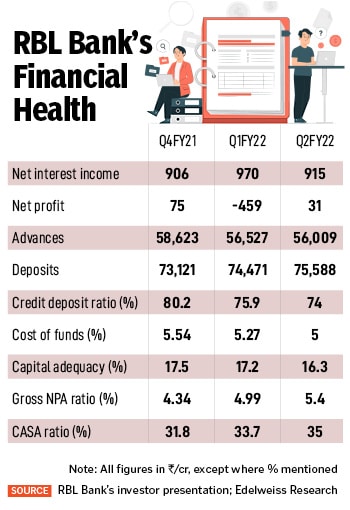
RBL Bank Stock falls 20%; interim CEO Rajeev Ahuja allays investor concerns
With the sudden exit of its veteran chief executive and no clarity on RBI's stern intervention, the bank's new business strategy is unclear, say analysts
 Vishwavir Ahuja of RBL suddenly quit his post on Christmas day to proceed on medical leave
Vishwavir Ahuja of RBL suddenly quit his post on Christmas day to proceed on medical leave
Image: Prasad Gori
Mid-sized RBL Bank’s interim Managing Director and CEO Rajeev Ahuja on Sunday tried to assuage investor concerns after its long-standing MD and Chief Executive Vishwavir Ahuja suddenly quit his post on Christmas day to proceed on medical leave. His exit from the bank, which coincided with the regulator appointing a serving Reserve Bank of India (RBI) officer on the RBL’s board, has left many questions unanswered.
The sudden management change has not gone down well with investors. The RBL Bank stock slid 19.9 percent on Monday to a 52-week low of Rs 138.35 at the Bombay Stock Exchange (BSE), due to the lack of clarity on Vishwavir Ahuja’s exit.
The RBI rarely takes stringent action over developments that might not threaten the future of a financial institution. It has, after all, in recent years, been proactive in taking action in the cases relating to IL&FS, Yes Bank, PMC Bank, Ujjivan Small Finance Bank, Dhanlaxmi Bank and the erstwhile Lakshmi Vilas Bank, by either appointing new statutory auditors or additional RBI-nominees to the boards of these banks.
The RBI had, in June, already approved a one-year extension in term for Vishwavir Ahuja, against a three-year term to which the bank’s shareholders had given a nod. So what warranted the entry of an RBI-appointed Yogesh Dayal as an additional director on the board of the RBL? And would that trigger Vishwavir Ahuja to leave a bank he nurtured from an old private sector [Ratnakar Bank] to an aggressive, technology-led, retail banking-focussed bank in just 11 years? Seems otherwise.









